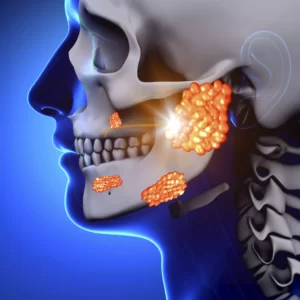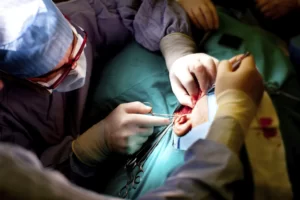Salivary Gland Lumps
Home | Services | Head And Neck | Salivary Gland Lumps
What are salivary Gland lumps?
Salivary gland lumps are lumps that develop in our salivary glands. They can either be benign (non-cancerous) or malignant (cancerous).
There are hundreds of salivary glands around and in the mouth. Some of these glands are so small, you need a microscope to see them.
 You have 3 sets of “major” salivary glands on each side. These are:
You have 3 sets of “major” salivary glands on each side. These are:
The parotid glands. These are located right in front of your ears and are your largest salivary glands. Around seven out of 10 salivary gland tumors develop here. Most are benign, but most malignant (cancerous) tumors start at the parotid glands.
The sublingual glands. These are the smallest and are located under the floor of your mouth below either side of your tongue. It’s rare to have tumors start in these glands.
The submandibular glands. These are under your jaw and are smaller. They produce saliva underneath your tongue. Around one to two out of 10 tumors begin in these glands and around half are cancerous.
You also have many tiny salivary glands inside your cheeks, in your lips and throughout your throat and mouth.
What are the symptoms of Salivary Gland Lumps?
Symptoms of salivary gland lumps may include:
- Unexplained painless or painful growth of the salivary glands
- Lump in the cheek, neck, or mouth
- Sensation of fullness over the salivary glands
- Numbness or changes of sensation over parts of the face
- Sudden onset of facial or neck pain
- Twitching or weakness of the facial muscles
- Paralysis of the face
- Difficulty with speech
- Unexplained weight loss, fever, or night sweats
What are some risk factors of developing salivary gland lumps?
Factors that could increase your chances of developing salivary gland tumors include:
- Exposure to substances in the workplace: Individuals who work with certain substances in the workplace could have a higher risk of salivary gland tumors. Jobs such as plumbing, asbestos mining and rubber manufacturing are linked with salivary gland tumors.
- Older age: While salivary gland tumors can develop at any age, they often develop in older adults.
- Radiation exposure: Radiation, like that used for treating neck and head cancers, potentially increases the risk of salivary gland tumors.
How are Salivary Gland lumps investigated?
Imaging
Imaging is frequently requested in order to further investigate the integrity of the salivary gland system and to assist in determining spread or extent of disease. This may take the form of ultrasound examinations, computed tomography (CT) scans, or Magnetic resonance imaging (MRI) scans.
Diagnostic Procedures
Salivary Gland Biopsy – Fine Needle Aspiration (FNA) can provide relevant diagnostic information during the evaluation phase of salivary gland tumors. During FNA, small glandular tissue samples are obtained and examined by microscopy to determine cellular integrity of the salivary gland. This information can provide a definitive diagnosis or rule out suspicion of other conditions.
What are some benign salivary gland lumps?
This list is not exhaustive as there are a variety of benign salivary gland tumors. These are the most common benign forms, including:
- Pleomorphic adenoma (a.k.a. benign mixed tumors)
- Warthin’s Tumor (Papillary cystadenoma lymphomatosum)
- Oncocytoma
- Monomorphic adenoma
- Canalicular adenoma
- Sebaceous adenoma
- Myoepithelioma
What are some malignant salivary gland lumps?
There are a variety of malignant salivary gland tumors. These are the most common malignant forms, including:
Mucoepidermoid Carcinoma
These are the most common salivary gland cancer type. Most of them begin in the parotid glands and don’t develop as often in minor salivary glands in your mouth or in the submandibular glands. While they can be an intermediate grade or high grade, they’re typically low grade.
Adenoid Cystic Carcinoma
This is often slow growing and is low-grade. But, it’s still extremely difficult to eliminate it completely since it often spreads along nerves. Also, these often come back following treatment (generally radiation and surgery), in some cases many years later. Patients’ prognosis is better for small tumors.
Adenocarcinomas
This is a term used for describing cancers that begin in gland cells (these are cells that usually secrete some type of substance). There are various different types of adenocarcinomas.
How are Salivary Gland Lumps Treated?

Benign salivary gland tumors are usually best removed through surgery, although there is no urgency to do so.
Malignant salivary gland treatment options will depend on the stage, size, type, grade and location of your cancer. The most common treatment for parotid gland cancer is surgery, particularly slower-growing and early-stage cases. It might involve the surgeon taking part of your salivary gland out, or the entire gland. They may remove your lymph nodes and possibly perform some reconstructive work on your neck and face.
Chemotherapy and radiation in general are not first line treatments for this type of cancer, except in more advanced cases. Radiation therapy may be indicated in certain malignant cancers even after surgery.
Table Of Content
conditions We treat
- Thyroid nodules
- Cancer of the Thyroid
- Salivary Gland lumps
- Salivary Gland and/or Salivary Duct Stones
- Enlarged Cervical Lymph Nodes
- Cancers of the Head and Neck Region
- Nasopharyngeal Cancer (NPC)
- Lesions in the Mouth & Oral Cavity
Our Treatments
- Hemi / Total Thyroidectomy
- Salivary gland removal (submandibular / parotid gland)
- Removal of salivary duct stones
- Excision of Cervical Lymph Nodes
- Excision of Mouth & Oral Cavity Lesions








